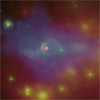CXC Home | Search | Help | Image Use Policy | Latest Images | Privacy | Accessibility | Glossary | Q&A
Tour of G54.1+0.3
Quicktime MPEG
Data from the Chandra X-ray Observatory and the Spitzer Space Telescope were combined to create this image of the dusty remains of a collapsed star. This object, known as G54.1+0.3, is a supernova remnant some 20,000 light years from Earth. The white object near the center of the image is a dense, rapidly-rotating neutron star called a pulsar that was left behind after the star collapsed. The pulsar generates a wind of high-energy particles, seen in the Chandra data, that expands into the surrounding environment, illuminating the material ejected in the supernova explosion. This infrared data shows a shell of dust and gas that's being dispersed back into space where it one day may become part of a new generation of stars and planets.
[Runtime: 00:58]
Quicktime MPEG
Data from the Chandra X-ray Observatory and the Spitzer Space Telescope were combined to create this image of the dusty remains of a collapsed star. This object, known as G54.1+0.3, is a supernova remnant some 20,000 light years from Earth. The white object near the center of the image is a dense, rapidly-rotating neutron star called a pulsar that was left behind after the star collapsed. The pulsar generates a wind of high-energy particles, seen in the Chandra data, that expands into the surrounding environment, illuminating the material ejected in the supernova explosion. This infrared data shows a shell of dust and gas that's being dispersed back into space where it one day may become part of a new generation of stars and planets.
[Runtime: 00:58]
(Credits: X-ray: NASA/CXC/SAO/T.Temim et al.; IR: NASA/JPL-Caltech)
Return to G54.1+0.3 (March 29, 2010)



